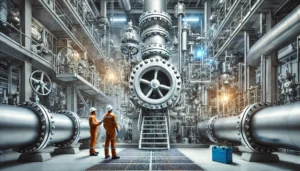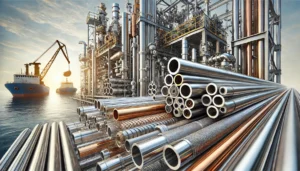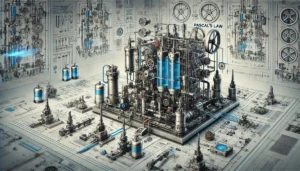Piping systems are essential in every sector such as oil and gas, chemical processing, water supply, and power plants. The formulation of proper piping material makes sure that all the requirements such as reliability, safety, and effectiveness are met. Each material has different features which makes it fit for a specific purpose.
The purpose of this blog is to provide valuable information about the major ten pipes and the characteristics that make them useful together with the popular industries that use them. This way you have an idea how to choose the right materials for your pipes.
1. Carbon Steel
Properties;
Carbon steel is inexpensive and possesses good strength which makes it widely used. The composition is mainly of iron and carbon along with some other elements in smaller quantity. It can also offer superb toughness and handle a lot of pressure and temperatures.
Applications;
Carbon steel pipes are used all across the oil and gas industries, as well as in water distribution networks and in high pressured steam pipes. Being low priced, it is widely used in larger commercial projects. The downside is that it is susceptible to corrosion and so protection methods such as the use of coatings or linings are important.
Example: Carbon steel pipes find applications in the transmission of crude oil because they can handle a lot of pressure.
2. Stainless Steel
Properties:
Stainless Steel is a combination of iron, chromium and nickel, well-known for its ornamental look and resistance to corrosion. It is very strong and perfect for use in harsh conditions and in extensive temperature ranges.
Applications:
Stainless Steel is highly utilized in food processing and serving, pharmaceuticals, and chemical industries owing to its non-reactive and sanitary properties. It is also the choice in industries working at elevated temperatures and pressures.
Example: Stainless steel pipes are used in desalination plants in different parts of the plants due to their high resistance to chloride corrosion.
3. GRE (Glass Reinforced Epoxy)
Properties:
GRE is a sandwich material of fiber and epoxy resin. It is lightweight, watertight and insulated and thus it is used for specific applications only.
Applications:
GRE is commonly used in pipes in offshore oil and gas platforms, in desalination and in chemical industry. Its lightweight makes it effective for instance where there is a need to reduce weight on certain systems or installations.
Example: GRE pipes are suitable to be used in offshore platforms for fire water systems due to their good corrosion resistance.
4. Copper-Nickel (Cu-Ni)
Properties:
Copper-nickel alloy is considered the only mixture which possesses remarkable corrosion resistance to saltwater and marine growth. No difficulty is experienced on these materials with respect to thermal conductivity and strength.
Applications:
Cupronickel alloy has a variety of applications such as shipbuilding, oil platforms, heat exchangers and condensers, especially in marine industries.
Example: Usage of cupronickel pipes finds application for seawater cooling systems because of their high resistance toward saltwater.
5. PVC (Polyvinyl Chloride)
Properties:
Pvc is light weight as well as cheap thermoplastic material. Pvc is chemically non corrosion, non conductive, and easy to install. But it is poor in temperature sustenance and can’t be used in high pressure work.
Applications:
Pvc can be found in water distribution systems, drainage works, and low temperature liquid genus work in chemical plants.
Example: Use of PVC pipes is mostly noticed within household plumbing and plumbing works in commercial buildings for liquid supply purposes.
6. HDPE (High-Density Polyethylene)
Properties:
Hdpe is a lightweight pliable thermoplastic that can resist abrasion, impact or even extreme chemicals. This can withstand lower temperature but is not very frequently used as it is used for long period of time.
Applications:
Due to its resistance to cracking, hdpe is widely used in gas, sewerage and self irrigation and its flexibility facilitates movement of the ground.
Example: Among the many applications of HDPE pipes, piping slurry during mining operations is most popular due to the additives’ protection against abrasion.
7. Ductile Iron
Properties:
A great material with an impressive corrosion resistance when coated is ductile iron. It is able to sustain most of the benefits that a cast iron can provide in a manner that offers more impact resistance, elasticity and more.
Applications:
Ductile iron is abundantly used within fire protection systems, industrial piping and pretty much in any type of water or wastewater pipeline.
Example: Due to ductile iron pipes great endurance and strength, they can be easily found within municipal water supply networks.
8. Aluminium
Properties:
Aluminium is less dense in comparison along with the ability to resist corrosion and with the advantage of thermal conductivity. However, it can be simple to fabricate and install which has its benefits for some commercial industries.
Applications:
Compressed air systems, HVAC, and in many lightweight shaped structural parts often use aluminum piping.
Example: Car A/C piping systems use aluminium pipes as they can offer a great deal of thermal conductivity but with a small weight.
9. Alloy Steel
Properties:
Many additional components including carbon steel alloyed with manganese, molybdenum, or chromium make up alloy steel. It is characterized by increased mechanical strength and resistance to rust. Alloy steel is able to withstand harsh heat and cold.
Applications:
Alloy steel is used in a lot of refineries, power plants and within the petrochemical industry due to its ability to withstand high temperatures.
10. CPVC (Chlorinated Polyvinyl Chloride)
Properties:
CPVC is a thermoplastic with excellent chemical and heat resistance. It is more durable than PVC and can handle higher temperatures, making it suitable for industrial applications.
Applications:
CPVC is commonly used in chemical transport, hot water distribution, and fire sprinkler systems. It is also preferred in applications requiring resistance to acidic or alkaline substances.
Example: CPVC pipes are used in chemical processing plants to transport caustic solutions safely.
Conclusion
Selecting the right piping material is essential for ensuring safety, efficiency, and cost-effectiveness in industrial systems. Materials like carbon steel and stainless steel excel in strength and durability, while GRE and Cu-Ni offer specialised benefits for corrosion-prone environments. Thermoplastics like PVC and HDPE are ideal for lightweight, non-corrosive applications, whereas alloy steel and ductile iron are best suited for high-pressure and high-temperature conditions.
By understanding the properties and applications of each material, industries can make informed decisions to optimise their piping systems for specific operational needs.










